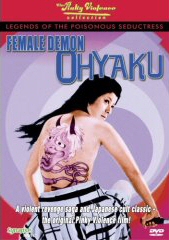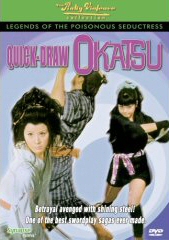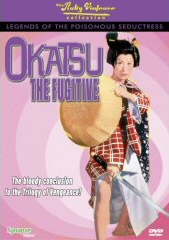Poetic and unrelentingly sadistic in their appreciation of pain, tragedy, and the ancient art of vengeance, films focusing on the debasement and revenge of women provoke even as they entertain. Easy to charge with a degree of misanthropy and sexism, these celluloid testaments to our human love of carnage and drama may also be seen as vehicles of liberation for the so-called weaker sex. Indeed, the sexually potent and physically powerful women depicted in finer exploitation films are rarely helpless victims, more often capable of putting the hurt on the male counterparts who took sexual or emotional advantage of them. This is particularly true in the case of Asian cinema, where the sub-genre of the warrior woman is milked for its resonance of liberation as well as for its carnal titillation and exploitative fervour. This is particularly true in the Pinky Violence and Female Warrior sub-categories. Kicking ass and traditional perceptions about women and their place in society, Asia embraced the dual, multi-faceted nature of Woman long before Western mavericks took notice. Of course the earliest depictions of resourceful and deadly females can be traced back to the earliest religious traditions and myths of the matriarchal societies to whom the ideal woman represented life and death. Maiden, Mother, and Crone: the archetypal Woman which these films in some ways represent -- femininity itself -- was the giver of life, the seducer/nurturer, and, finally, death itself. These same three aspects. Drenched in myth and metaphorical significance, are emphasized in each of the films that comprise the Legends of the Poisonous Seductress series now available for the first time ever in America on DVD in comprehensive and gorgeous re-mastered editions. Female Demon Ohyaku, Quick Draw Okatsu, and Okatsu the Fugative are literate, stylistic, and carefully directed examples of this particularly satisfying genre of sin, female flesh, and violent tragedy. Sleek, suspenseful, and chock full of all the blood, violence, and action (did I mention nudity?) that then adventurous film fan could want, each of these pre-runners of the modern female anti-heroine are also poetic enough to satisfy as serious drama.
Female Demon Ohyaku

The first in the Legends Of The Poisonous Seductress trilogy, Female Demon Ohyaku embraces several of the visual and thematic qualities that are seen throughout the genre -- grim, sadistic violence, sexual deviancy, and dazzling swordplay are all on hand, and along with a polished performance from Junko Miyazono (Ohyaku) set the tone for the grand decadence to come. A watershed moment between the traditional crime films of Japan and the sexploitation roughies that would become more and more violent as people's ideas became more liberal towards skin and violence, Female Demon is historically significant as well as consistently entertaining. A pivotal bridge between the historical swordplay film and the increasingly grim realistic 'bad girl' cinema that was making itself felt during the 60's, this beautiful ballet of blood, brutality, and cold erotic appeal was a clear forerunner of the 'Pinky Violence' films that celebrated deviant themes with sensationalized action and fetishistic images.
Poor Ohyaku has had a rough life. Her mother was a prostitute who tried to kill them both and the suicide attempt left the otherwise beautiful girl with a nasty scar along her back. Now grown, Ohyaku works as a performer, making her living walking across tight ropes for the amusement of the male crowd who gather to watch. The local magistrate, Sengoku, takes a liking to her and wants Ohyaku as his own but she refuses. Thankfully when things get rough, a young samurai named Shinsuke comes to her aid. She becomes instantly smitten with him and after they make love he refers to her as wife, the two are obviously quite in love. How unfortunate then that Sengoku's plan to steal a shipment of gold headed towards the mint gets blamed on Shinsuke and some of his comrades. Shinsuke and Ohyaku are captured, he gets decapitated and she gets sent to a prison colony to work in the mines of Sado Island . Before she's sent away, however, Ohyaku swears she'll get revenge. Once at the penal colony, she begrudgingly befriends a burly man known as Bunzo The Iron Barbarian. He shows her the ropes and helps her out in the mine but soon the warden and his wife decide they can probably sell Ohyaku as a concubine and so they take her out of the general population and clean her up a bit. Oman , the wife, takes an instant liking to her and asks to tattoo her back. Ohyaku agrees and over a period of time, Oman inks a demon onto her and once it's finished, she seduces her. While all of this is going on, however, Ohyaku is planning her escape and when a certain nobleman arrives at the island for a routine inspection, she decides the time has come to make a break for it and exact her revenge.
An uneven if emotionally taunt exercise in vengeance and redemption, Female Demon Ohyaku makes up for its slow midway mark with a finale drenched in sexual allure, cruel murder, and scintillating swordplay. Taking the archetypal image of the 'Savage Woman' and placing it in a modern context of increased violence and sexual explicitness, this dazzling storm of quality exploitation also artfully combined mythic associations of the mysterious/deadly/sexy female with the vigilante/vengeance seeking character so very popular at its time of production. The amount of spilled blood and bare flesh is amazing considering the period, particularly as it is employed as an accompaniment to the story, not a replacement! Director Yoshihiro Ishikawa cut his teeth writing and helping direct features with and for Nobuo Nakagawa, and while he has never reached the level of cult status of his contemporaries, he displays an obvious energy and sense of style in this picture, moving the action along at an admirable pace (once things get started) and allowing us to feel real emotions for characters whose predicaments we can believe in. Junko Miyazono embodies all the mythic relevance of her character with a mysterious, cold, but appealing grace and eroticism. Attractive and deadly at the same time, she is all the mysteries and temptations of the female -- particularly when kicking ass.
Female Demon Ohyaku is treated with the attention and respect -- the zeal -- which we are used to seeing in Synapse product. The picture itself is re-mastered in an aspect ratio of 2.35.1, enhanced for anamorphic televisions. The visuals of clear and sharp, and the levels of black carefully defined. While minor grain is present, it is in no way sever enough to hamper the viewing experience. Audio is featured in Dolby Digital Mono in Japanese with optional English subs. No background interference is noticeable.
Extras are less spectacular than we have seen before from Synapse but just as professionally assembled. While resembling more truthfully a scene-by-scene description of the plot than a critical conversation, the Audio Commentary by Chris D. is nevertheless well informed and worthwhile, particularly when exploring the film's possible inspirations and details concerning the director. Theatrical Trailers for the entire series are next, rounded out by an Insert Booklet with an essay (again by Chris D.) on Japanese 'bad girl' films and the swordplay genre.
Quick Draw Okatsu

The second film in the Legends of the Poisonous Seductress series, Quick Draw Okatsu is a more exploitative and fast paced effort. Reprising her role, Junko Miyazono stars as Okatsu, the dedicated daughter of a swordsman wielding a bloody trail to vengeance. Directed by legendary supernatural guru Nobuo Nakagawa, whose most effective films explored gothic moralistic themes with color and vitality, this entry in the series exchanges the moody, dream-like mood of the first feature for a reckless, action orientated orgy of violence and skin. This isn't to imply that Nakagawa doesn't heap plenty of atmosphere into the fast paced narrative, he does. In fact, his two chapters are both more moody and exploitative than the original. Evoking pathos and pity alongside bleeding throats and rape, Nakagawa brings his subject matter closer in terms of both style and story to the Pinky Violence films that would, in many cases, lack his organic sense of rough poetry.
Okatsu's life is torn asunder when her father becomes embroiled in a conflict with Shiozaki, the local head hancho. Before you can scream 'sexploitation!' her and her father are lured into a dungeon and out to a number of sadistically erotic tortures, showing glimpses of the excesses that would later grace the Category 3 films. After surviving a nasty rape, the execution of her father, and debasement, Okatsu vows to wreak havoc on the men who wronged her. She finds solace, of sorts, in a young warrior named Rui. Together they sever limbs, find love, and carve a bloody trail of fate through the crooked men that protect Shiozaki.
While Junko is the external symbol of the picture, Nakagawa's assured direction and deft handling of both character and action is the true star. Granted, the story is nothing new, taking cues from oral myths and tragedies as old as humankind, but the director puts such energy and technical skill into his set ups, camera positions, and pacing that one can't help but be swept away. Graphic violence, sex, and sadism enhance the threadbare revenge plot, and everything is draped with bleeding color. While not as masterful as Jigoku, Nakagawa displays a thorough understanding of the swordplay and anti-hero genres.
Quick-Draw Okatsu enjoys an aspect ratio of 2.35.1. Captured in anamorphic widescreen, this transfer is clean and polished. Little grain hampers the clean, bold colors and clarity of the imagery. A Japanese language track in Dolby Digital Mono includes English subs. These are clean with no outside interference or distortion.
Extras again include an Audio Commentary with Chris D., who gives a solid if less than enthusiastic history of the film, spending far too much time relating the narrative action (which we can see for ourselves). Of more interest is his discussion of Nobuo Nakagawa's career. The same Trailers are included on this disc, along with a Nobuo Nakagawa Poster Gallery and Text Biography. Reversible Cover Art and an Essay round out this release.
Okatsu the Fugitive

The final entry in this bold, harshly beautiful series of swordplay, bare ass, and sadism, Okatsu the Fugitive again features Junko in the title role. Also returning is Nobuo Nakagawa, who brings the same devotion to atmosphere and action displayed in Snake Woman's Curse and Mansion of the Ghost Cat to his highly stylish interpretation of the 'Bad Girl' seeking vengeance. Ranging from harsh yet oddly attractive scenes of torture to awesome displays of sword skill, this variation on a theme again emphasizes visual integrity and colorful action.
When Okatsu's father attempts to bring justice to some important men in his village by directing the governments attention to an illegal tobacco scheme, he is kidnapped and beaten. Right before her wedding to a man her father believes to be honorable, Okatsu is forced to witness the rape, torture, and murder/suicide of her parents. Only later does she realize that even her fiancÚ is malevolent, working against her for his own financial security. When Okatsu meets a mysterious swordsman of prodigious skill, she gains an alley on her quest for revenge. A band of outcasts accompanies her as she slices her way through corrupt officials, scheming politicians, treacherous Madams, and the hypocrisy of her old lover.
Essentially little different in narrative construction or theme from the second film in the series, there is again no lack of mood or action. Violence and cruel sexuality are in full display, and house even the more quite moments with impressive tension. This film -- and the series as a whole -- is that rare breed of entertainment that falls between art and entertainment, tantalizing and challenging simultaneously. Smart, bold in execution, and gorgeous, this is an important release for Asia cinema enthusiasts, and a fitting testament to another side of the director's personality.
Okatsu The Fugitive is offered in 2.35.1 anamorphic widescreen. The picture is clean save for brief appearances of grain that do little to distract from the action or lyricism of Nagakowa's compositions. A Japanese Dolby Digital track is again provided with English subtitles. And, again, there appear to be no issues of interference or background hissing. Extras this time out include Theatrical Trailers for each film of the series, a Nakagawa Poster Gallery, and Biography.
Review by William P. Simmons
| Released by Synapse |
| Region 1 - NTSC |
| Not Rated |
| Extras : |
| see main review |